| Article ID | Journal | Published Year | Pages | File Type |
|---|---|---|---|---|
| 10372752 | Journal of Hazardous Materials | 2011 | 8 Pages |
Abstract
An electrochemical technique was adopted to investigate the removal of Cr(VI) species and total chromium (TCr) from aqueous solution at a laboratory scale. The electrodes of stainless steel nets (SSNE) coated with single wall carbon nanotubes (SWCNTs@SSNE) were used as both anode and cathode. Three parameters, including solution pH, voltage and electrolyte concentration, were studied to explore the optimal condition of chromium removal. The optimal parameters were found to be pH 4, voltage 2.5Â V and electrolyte concentration 10Â mg/L. Under these conditions, the Cr(VI) and TCr removal had a high correlation with the amount of SWCNTs coated on the electrodes, with coefficients of the regression equations 0.953 and 0.928, respectively. The mechanism of Cr(VI) removal was also investigated. X-ray photoelectron spectroscopy (XPS) study and scanning electron microscope (SEM) picture showed that the process of chromium removal involved the reduction of Cr(VI) to Cr(III) on the cathode, and then the adsorption of Cr(III) by SWCNTs on the cathode. The study results indicated that the proposed method provided an interesting means to remove chromium species from aqueous solution, especially Cr(VI) in acidic condition.
Keywords
Related Topics
Physical Sciences and Engineering
Chemical Engineering
Chemical Health and Safety
Authors
Yao-Xing Liu, Dong-Xing Yuan, Jun-Mei Yan, Quan-Long Li, Tong Ouyang,
